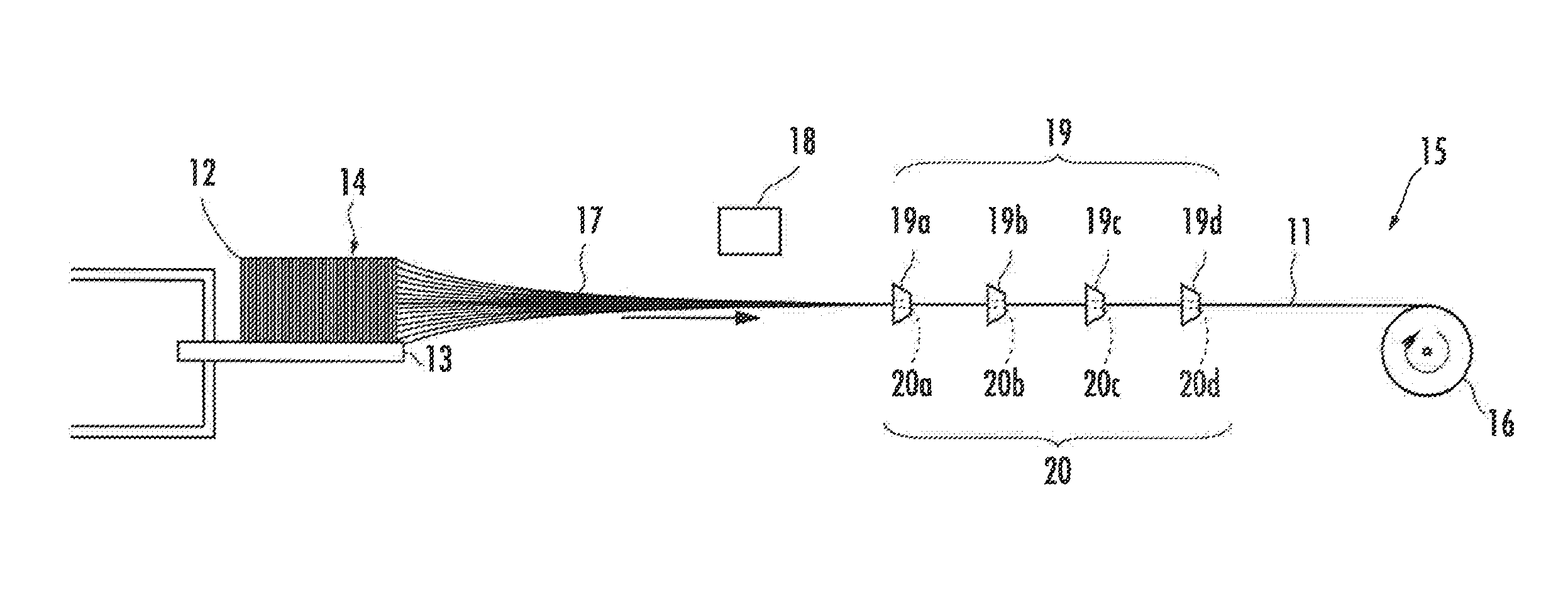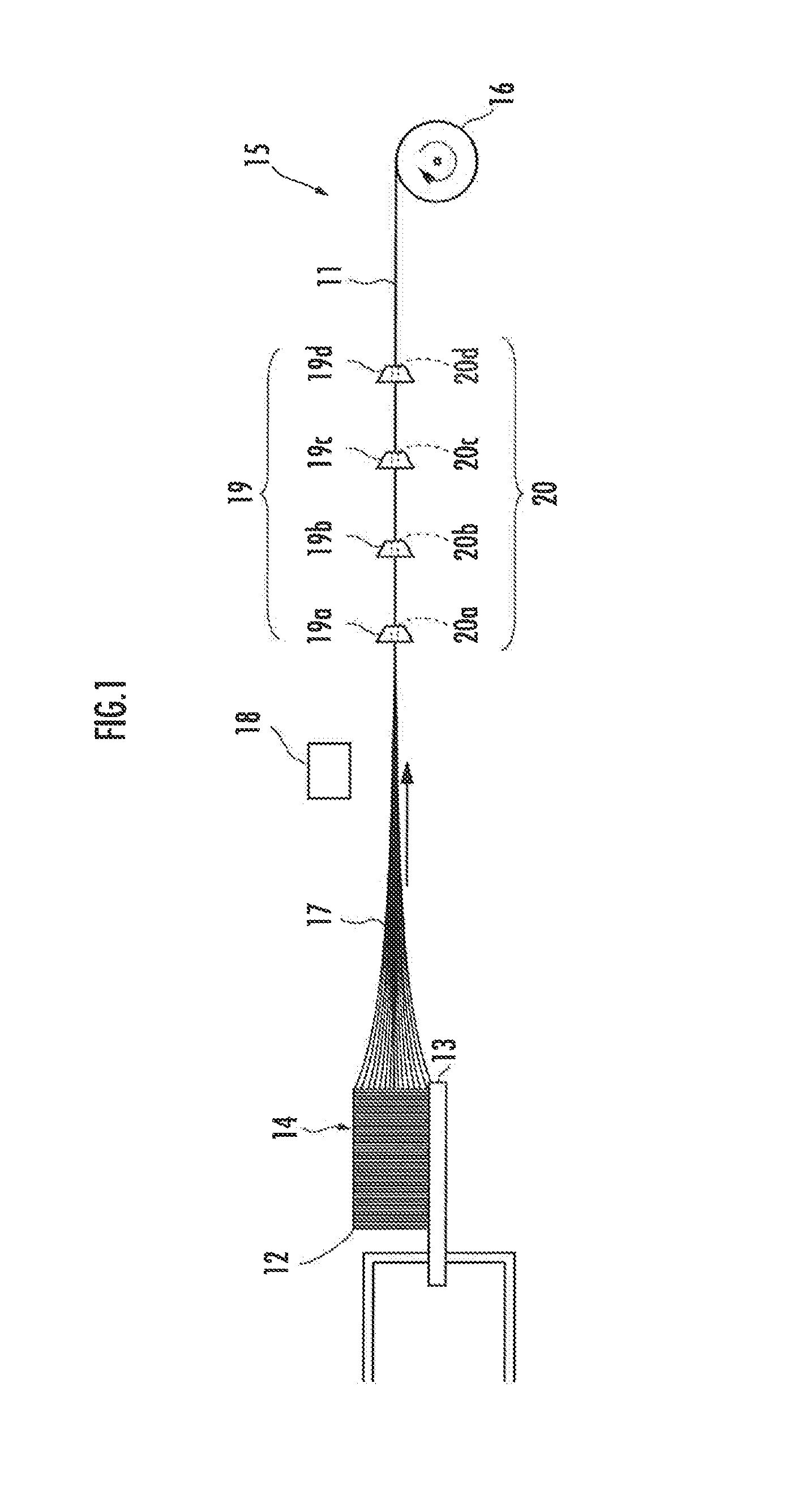Carbon nanotube fiber and method for producing the same
- Summary
- Abstract
- Description
- Claims
- Application Information
AI Technical Summary
Benefits of technology
Problems solved by technology
Method used
Image
Examples
example 1
[0087]In this Example, a plurality of carbon nanotubes 12 were first grown by a CVD method on a silicon substrate 13 (5 cm in length, 5 cm in width, and 500 μm in thickness) on which an Al film (5 μm in thickness) and a Fe film (2 μm in thickness) had been deposited to form a carbon nanotube forest 14. In the resulting carbon nanotube forest 14, the carbon nanotubes 12 had an average diameter of 10.6 nm, an average length of 394 μm, and a density of 84 mg / cm3.
[0088]Next, in a spinning apparatus 15 shown in FIG. 1, a plurality of carbon nanotubes 12 were paralleled in a state where they are not twisted from the carbon nanotube forest 14 by a drawing unit 16 to thereby form a carbon nanotube assembly 17 in which the plurality of the carbon nanotubes 12 are assembled.
[0089]Next, after impurities in the resulting carbon nanotube assembly 17 were removed by a blower as an impurity removing unit 18, the carbon nanotube assembly 17 was successively inserted into the pores 20a, 20b, 20c, an...
example 2
[0095]In this Example, a carbon nanotube assembly 17 was first formed in exactly the same manner as in Example 1.
[0096]Next, a carbon nanotube fiber 11 was formed in exactly the same manner as in Example 1 except that the resulting carbon nanotube assembly 17 was inserted only into the pore 20a of the die 19a.
[0097]Next, the cross section of the resulting carbon nanotube fiber 11 was observed by SEM to thereby determine the cross-sectional filling rate, and it was found to be 9.0%.
[0098]FIG. 9A shows an enlarged front picture of the carbon nanotube fiber 11, and FIG. 9B and FIG. 9C each show an enlarged cross-sectional picture of the carbon nanotube fiber 11. FIG. 5C and FIG. 9C reveal that the carbon nanotube fiber 11 of Example 1 is in a state where a plurality of carbon nanotubes 12 are gathered with higher density and has a higher cross-sectional filling rate as compared with the carbon nanotube fiber 11 of this Example.
[0099]Next, the resulting carbon nanotube fiber 11 was mea...
example 3
[0100]In this Example, a carbon nanotube assembly 17 was first formed in exactly the same manner as in Example 1.
[0101]Next, a carbon nanotube fiber 11 was formed in exactly the same manner as in Example 1 except that the resulting carbon nanotube assembly 17 was inserted into the pore 20a of the die 19a and the pore 20b of the die 19b.
[0102]Next, the resulting carbon nanotube fiber 11 was measured for a cross-sectional filling rate, electrical conductivity, tensile strength, and rigidity in exactly the same manner as in Example 1, and the cross-sectional filling rate, electrical conductivity, tensile strength, and rigidity were found to be 18.2%, 170 S / cm, 0.23 GPa, and 10.8 GPa, respectively. The results are shown in Table 1 and FIGS. 6, 7, and 8.
PUM
| Property | Measurement | Unit |
|---|---|---|
| Length | aaaaa | aaaaa |
| Fraction | aaaaa | aaaaa |
| Angle | aaaaa | aaaaa |
Abstract
Description
Claims
Application Information
 Login to View More
Login to View More - R&D
- Intellectual Property
- Life Sciences
- Materials
- Tech Scout
- Unparalleled Data Quality
- Higher Quality Content
- 60% Fewer Hallucinations
Browse by: Latest US Patents, China's latest patents, Technical Efficacy Thesaurus, Application Domain, Technology Topic, Popular Technical Reports.
© 2025 PatSnap. All rights reserved.Legal|Privacy policy|Modern Slavery Act Transparency Statement|Sitemap|About US| Contact US: help@patsnap.com



